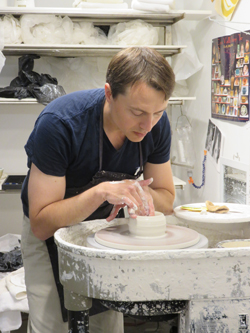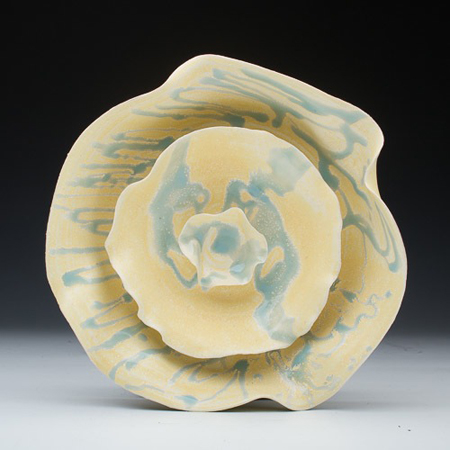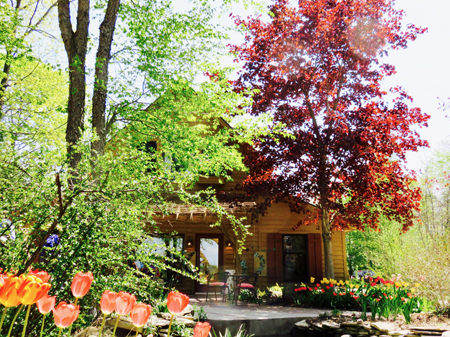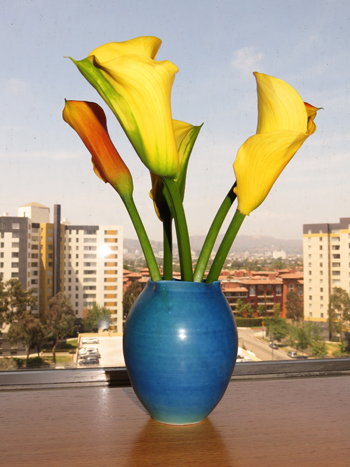Profile: A Midwestern Master of Porcelain — Chad Luberger
by Norman Kolpas
arttimesjournal April 6, 2019
In the world of pottery, no other material compares to porcelain. Based on the clay compound called kaolinite, when kiln-fired at temperatures from 2,200°F to 2,600°F it achieves an incomparable strength and durability that-particularly in combination with its seeming delicacy and near-luminous quality-elevates it to the pinnacle of the ceramic arts.
In China, where kaolinite is mined to this day, some of the world's traditional porcelain ware is still produced in rural workshops that have changed little from early times. Starting in the 16th and 17th centuries, traders carried the clay's secrets to Japan and then to Europe, where companies still in operation-including Meissen (Germany), Sèvres (France), Doccia (Italy), and Wedgwood and Spode (England)-established reputations that made their names synonymous with fine porcelain.
Today, innovative artists have also been exploring porcelain as a medium. The celebrated English ceramicist and award-winning author Edmund de Waal, whose installations of multiple sleek geometric porcelain pieces have appeared in top museums and galleries from London to New York, Vienna to Beverly Hills, chronicled his own deeply personal exploration of porcelain's history in the 2016 book The White Road: Journey Into an Obsession. And Chinese political activist and conceptual artist Ai Weiwei commissioned 1,600 artisans in his homeland to handcraft and paint more than 100 million little sunflower seeds that he spread across the floor of a 1/3-acre hall in London's Tate Modern museum for an Autumn 2010 installation.
I'd read de Waal's book, enthralled by the detailed research and passionately described first-hand experiences he shared. And I'd marveled first-hand at Ai Weiwei's Tate Modern exhibit-which ultimately led that London museum to cordon off the installation after some visitors experienced respiratory problems from the airborne dust of stray ceramic seeds unwittingly crushed underfoot.
|
Gradually, I'd found myself seized by a desire to possess at least one small fine porcelain piece of my own. But I didn't want just any traditionally styled porcelain. My tastes don't run to the ornate contours or delicately painted patterns of Ming vases, Sèvres tureens, or Wedgwood teapots. I wanted a practical piece that suited my own preference for spare, unornamented works with sleek modern contours that express porcelain's innate delicacy, beauty, and strength.
To my delight, I found just such a porcelain vessel at Plum Bottom Pottery and Gallery, opened in June 2007 by artist-potter Chad Luberger. The gallery and studio is set idyllically on 20 acres of rural solitude in Door County, Wisconsin, a serenely beautiful landscape of cherry and apple orchards, dairy farms, idyllic parklands, scenic coastlines, and warmheartedly welcoming towns on a slender peninsula jutting northward between Green Bay and Lake Michigan.
I'd come to Door County on a springtime getaway with no plans at all to buy any art pottery. My wife Lynn Dubinsky and I were simply seeking to taste part of the country we'd heard much about but never experienced before.
And we experienced tastes aplenty. They came in literal form in the superb French toast stuffed with local Montmorency cherries and cream cheese served at the White Gull Inn in the town of Fish Creek, a specialty that won the Best Breakfast in America Challenge on ABC's "Good Morning America"; deep-fried cheese curds and an old-fashioned banana split at the vintage-1906 Wilson's Restaurant & Ice Cream Parlor in Ephraim; and a sampling of artisanal cheeses at Wisconsin Cheese Masters in Egg Harbor, followed by samples of local wines at Harbor Ridge and Door 44 wineries. We enjoyed home-style fresh-baked cherry pie from Sweetie Pies in Fish Creek; woke up to an eye-opening cup of freshly roasted espresso from Vicki Wilson's Door County Coffee & Tea Co. in Sturgeon Bay; and ended the day with an authentic "fish boil" dinner of Lake Michigan whitefish at The Old Post Office restaurant in Ephraim.
But, if anything, memories of our figurative tastes of Door County linger even more indelibly than the edible ones. We won't forget the sweeping vistas of Lake Michigan we viewed during a stop on the scenic tour offered by Door County Trolley, which features old-fashioned red-painted trolley cars that glide the roads on tires instead of rails; visiting Fish Creek's Edgewood Orchard Galleries, where the works of more than a hundred local or regional artists and craftspeople are displayed in welcoming vignettes that offer a good idea of how they might actually look once you get them home; or the lighthearted absurdity of scooting upright on Segways along dirt and gravel roads through cherry orchards lining the shores of the lake when we took a safe-yet-freewheeling excursion led by Segway the Door Tours.
In brief, we felt a world away from our everyday lives in Los Angeles. What more could one ask of a getaway trip?
 Luberger cuts a piece of porcelain clay body. (photo: Norman Kolpas] |
None of those experiences, however, prepared me for the simple surprise of Plum Bottom Pottery and Gallery, which I visited solo while Lynn-who is passionately interested in the intricacies of fine spirits, wines, and beers-sampled locally brewed bright and hoppy beers at Door County Brewing Company and sipped award-winning cherry wine on the lovely outdoor deck at Simon Creek Vineyard & Winery. Despite Door County's rambling rural nature, Plum Bottom seemed even more off the beaten track. We veered from Route 42, a.k.a. Egg Harbor Road (named for the nearest town), one of the two main north-south highways that traverse the length of the peninsula, and found ourselves instantly rambling along the country lane called Plum Bottom Road. Just over a mile east, amidst the farmlands, a two-story cottage appeared in a wooded clearing, its front yard a fireworks array of tulips, lupines, and other blossoms.
Homey but spacious front rooms feature Luberger's porcelain creations, from simple vases, mugs, and other everyday items to art pieces such as his "Wall Flowers"-concentric yet freeform blossom shapes whose petal-like contours perfectly express porcelain's inherent combination of delicacy and strength. Works from a stable of more than 50 artists from around the country also appear in the gallery-potters and other craftspeople, including fine jewelry made by Luberger's wife, Angela Olson Luberger, and others she selects for display.
Luberger, who's in his early 40s but looks a good decade younger, is often there to greet visitors, not least because his own pottery studio occupies the unseen back portion of the building's ground floor. He invited me into the studio to watch him at work, and to talk about his own creative quest that ultimately led him to porcelain and then to open Plum Bottom.
Though highly circuitous, his journey seems inevitable in retrospect-perhaps simply because he's a man who quietly projects an aura of living as he was meant to live. His own family's roots in Door County trace back four generations to his great-great grandfather, who bought land on Lost Lake just a few miles away. Young Chad grew up on the family homestead from the age of two and a half until eight, before moving to the Upper Peninsula of Michigan.
Throughout his school years, he had no particular involvement in the visual arts. "My passion was theater," he says. He pursued that subject at Carnegie-Mellon University in Pittsburgh and then went on to work for five years in Hollywood, where he had roles in a TV holiday movie directed by Sally Field, an indie horror film, and episodes of such series as Star Trek and J.A.G., as well as producing, writing, shooting, and editing his own short film. In the end, however, that exposure to the industry left Luberger asking himself, "Is this the life I want? And the answer just came back to me: No."
 The clay centered on his wheel, Luberger begins to form a vase. (photo: Norman Kolpas) |
So, at the age of 26, he sought solitude and perspective in Alaska, eventually moving to Anchorage, where he found meaning and fulfillment doing HIV outreach in local jails and native communities. Eventually, while dating a young woman from Homer, he decided to move with her to that small waterside town on the Kenai Peninsula south of Anchorage. And she introduced him to the wheel-thrown pottery she'd made in high school. "It had never crossed my mind that you could make pottery," Luberger says with a laugh. "I wanted to do something tangible like that, something I could finish at the end of the day and say, 'I made something real.'"
That autumn, he enrolled in the exceptionally well-equipped pottery studio program available during evenings at Homer High, with some twenty wheels and an assortment of high-quality kilns, all established with money paid to the community in compensation for the Exxon Valdez oil spill. "And in my first day of throwing on the wheel, it all made sense to me."
Not that Luberger was yet firmly on the path to Plum Bottom. Leaving Alaska (and his relationship) behind, he eventually thought he might go to law school, and while readying himself for entrance exams and applications, he wound up spending the summer and fall of 2005 staying with his grandparents back in Door County. When he mentioned to them that he might enjoy a diversion from waiting tables and bartending, his grandfather said, "You need to go up to the Potters Wheel in Fish Creek and meet Abe and Ginka Cohn."
Abraham Cohn, it turned out, was widely acknowledged as the man who literally fired up the art pottery scene in Door County. An American potter of distinction, he was recognized with numerous honors, including a Louis Comfort Tiffany Award in 1958; a Smithsonian Institution Purchase Award in 1961; and, in 1964, the first one-man show from a craftsman at Milwaukee's new Memorial Art Center. He and his wife, Ginka, also a potter, established Potters Wheel Gallery, the first pottery studio in Door County, back in 1956, living and working there as a summer respite from their home in Milwaukee. In 1976, they formed the Door County Potter's Guild, and finally moved to Fish Creek full time in 1994. (Cohn died at the age of 88 in 2013, two years after his beloved Ginka's passing.)
In 2005, Cohn was still very active as a potter himself as well as a mentor to rising talents. But Luberger was little aware of the man's national reputation when he approached the couple and "worked out a trade agreement" by which "I would work for an hour mowing their lawns or weeding their garden, and in exchange get an hour in their pottery studio." After the arrangement had begun, the young potter had a moment of revelation one hot summer morning. "I'd gotten up at 5 a.m. to weed in their garden for a couple of hours in exchange for a couple of hours in their studio. The sun was coming up, and I suddenly thought, What's going on here? You've found something that strikes a deep chord in you." From that point on, he says, "I just kept following what was feeling good, and that was ceramics."
With that goal in mind, Luberger next applied for and was accepted into an emerging artists program through the Peninsula School of Art, a respected nonprofit institution that had been established a short walk from the Cohns' place on land the couple had sold for that purpose. That provided him with a studio space, a small stipend to live on, and a show the following spring. The next April, the 30 or so ceramic pieces he had made sold out on his show's opening night. Luberger recalls the "Aha!" moment of thinking to himself, "Oh, wait! Maybe I can make a living doing this."
 One of Chad Luberger's "Wall Flowers" deconstructs conventional porcelain pottery to form a wall-mounted sculpture.. (photo: Chad Luberger) |
That very summer, he found a property complete with a nine-year-old house built with classic cedar siding on Plum Bottom Road, "just two and a half miles from my grandparents' place, with ten acres of prairie in the front and ten acres of woods in the back." It seemed too good to be true. "I took a huge risk, and I needed some help from my parents. But I could live and work here. So I bought the place."
At this point, the only element missing from Chad Luberger's story is porcelain. Though he'd trained in and worked with other clay bodies, he had been impressed by some porcelain pieces made about three decades earlier by Abe Cohn. "I was very attracted to how glassy, jewel-like, and refined they were." As if the fates were conspiring, he learned that the Chinese city of Jingdezhen, known as the birthplace of porcelain, was looking to form a sister city relationship with Door County, and in the early Autumn of 2006 Luberger suddenly found himself setting off to China for three months to study the traditional art of hand-thrown porcelain "in a walled complex where people would throw and glaze all day long."
In December 2006, he came home and briefly moved into Plum Bottom, before setting out for a grant-funded three-month intensive workshop at the Penland School of Craft in the Blue Ridge Mountains of North Carolina. There he studied the intricacies of modern porcelain work with Cynthia Bringle, a longtime resident artist, world-renowned potter, and Fellow of the American Craft Council. "From March to May, I was able to live, eat, and breathe porcelain. I got to make pots with her, and she taught me how to fire kilns by sight, smell, and sound rather than with the technical instruments a lot of potters use now."
After returning home to Door County, Luberger had only two months to create a body of work sufficient to open Plum Bottom Pottery & Gallery. "I found a porcelain clay body that I loved, and I started making pieces." On the first night alone of Plum Bottom's opening show on June 27, 2007, he was delighted to sell "easily half of about a hundred pieces," and he had to call on another ceramicist friend to bring in his own works to help refill the gallery's shelves.
Such a literally overnight success was the first of what Luberger says were "two thing that happened that summer that were really transformative" to his career. Soon, he got a call "out of the blue" from the Fairfield Center for Contemporary Art in nearby Sturgeon Bay-an institution (since closed) that had also shown works of major artists including Wassily Kandinsky and Henry Moore-offering Luberger a one-man show that October. While continuing to throw porcelain vases, bowls, mugs, and other vessels scaled to home tabletop use, he also quickly launched into creating a collection of larger-scale porcelain pieces as tall as three feet for the new exhibition. His show at Fairfield sold out on its opening night. "And for lack of a better word," he smiles, "the rest is history."
Today, Plum Bottom Pottery & Gallery continues to thrive, representing not only Chad Luberger's porcelain pottery but also "a rotating group of nationally collected potters and ceramic artists," along with painters, sculptors, and a stable of jewelry artists including Angela Olson-Luberger, his wife since November 2013. The couple, parents to two daughters, have also fashioned three idyllic vacation rentals on the gallery property, Door County Cabins. And recently Plum Bottom opened a second location in the charming downtown business district of Egg Harbor.
 Classical and perfectly symmetrical in its form, a porcelain bowl by Chad Luberger takes on a modern look with its abstract glaze pattern. (photo: Chad Luberger) |
Despite such thriving successes that could understandably make his attention stray, Chad Luberger remains ever dedicated to the art form he so fortuitously discovered. "I'm really at such a great place in my life right now with my family and my business," he says. "I'm excited to see where my work is going. It's a joy for me to sit down at my wheel."
That's exactly where I found him on a sunny springtime day, in his personal porcelain studio behind the main showroom at Plum Bottom's original location. I watched him use a length of wire to cut a piece about six inches long from a cylinder of porcelain clay and then, with expert, practiced hands, center it on his wheel before alternately pressing his thumbs down to form a hollow vessel and cupping his palms and fingers around the outside as the wheel spun to shape the spinning clay taller and taller, its walls ever thinner, eventually transforming into an elegant vase shape about three times as tall as the piece of clay had originally been. Finally, stopping the wheel, he began to flute the lip of the vase asymmetrically, giving the ancient medium of porcelain an elegant modern-day aspect. After bisque-firing, the vase would be coated with one or more of the fifty-plus glazes Luberger uses-"many of which I've developed myself"-and then fired again to achieve its final luminously colorful state.
The entire process amounted to an impressive performance by a young master of the medium. Indeed, says the theatrically trained Luberger, "My work is improvisational. I'll start with a very classic shape and then I'll just push it and pull it and even scratch it in ways that engage me and my imagination." He finds this medium, however, even more personally fulfilling. "The awards and adulation I was searching for as an actor didn't bring me very much happiness. Now, I not only get to make and hold these things in my hands every day, but I also get to see other people hold them and see their appreciation of my work. My goal now is to be in my gallery and see that year after year."
After talking with Luberger and watching him in action, I strolled back through Plum Bottom's gallery rooms to admire more of his recent creations. Some undeniably were meant to serve a practical purpose-including sturdy mugs, bowls, tumblers, and vases-while still possessing one-of-a kind artistic touches like gently undulating rims and aesthetically applied glazes in a range of shades from bright sky-blues to deep burnt umbers and patterns from delicate ombrés to seemingly random yet pleasing swirls, dots, and drips.
Still others crossed the borderland from utilitarianism into pure visual pleasure. I was impressed, for example, by those previously mentioned "Wall Flowers" with their blossom-like shapes. "They deconstruct the typical kinds of forms I've made, reassembling them into wall sculptures," he says.
|
As my time at Plum Bottom drew to a close, the moment came to select one of Chad Luberger's porcelains for myself. My eyes sweeping the display shelves, I felt myself drawn to a small, elegantly formed vase just shy of 5 inches tall and 4 inches wide at its midpoint, almost symmetrical but for three small outward juts spaced equally around its rim. The form pleased me as much as its saturated blue glaze, which looked evenly applied from a distance but up-close showed subtle horizontal gradations. I carefully lifted it from the shelf.
My purchase completed, a gallery assistant carefully wrapped it for me in multiple layers of bubble wrap. Surprisingly sturdy substance that porcelain is, the vase perfectly survived our flight back to Los Angeles, where-holding the cut flowers with which Lynn always brightens our ninth-floor apartment-it looks beautiful displayed against our northward views toward the Hollywood Hills three miles away.
Of course, that 1,700-mile distance between Door County, Wisconsin and Southern California is nothing compared to the ocean voyages porcelain ware made hundreds of years ago from Chinese villages to the finest tables in Europe and America. It's heartening to see the material enduring not only in traditional form but also as a modern medium, inspiring a home-grown artist like Chad Luberger to play his own role in keeping porcelain vibrantly alive and relevant today.
Norman Kolpas is a Los Angeles-based writer on art, architecture, travel, dining, and other lifestyle topics. His work has appeared in publications including Southwest Art, Mountain Living, Sunset, The Times of London, and the Los Angeles Times. Norman also teaches nonfiction writing in The Writers' Program at UCLA Extension.


